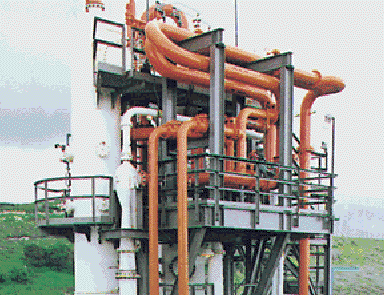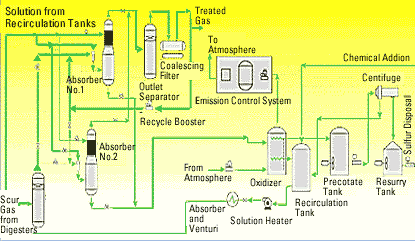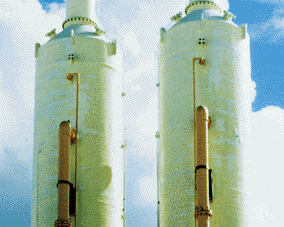Catalytic Oxidation Systems Kill Odors at Water and Wastewater Plants
The first example is the installation at the huge Hyperion wastewater treatment plant that serves a large part of the population in the Los Angeles area. This facility in Southern California treats nearly 420 million gallons of wastewater every day (mgd) and generates over 475 tons of raw sludge daily.
The concentration of H2S in the exhaust gas from the plant's digesters has to be controlled so that oxides of sulfur (SOx) emissions from the on-site digester gas combustion system could be kept within regulatory limits. With these emissions under control, the digester gas can be burned as fuel to generate steam for heat or electricity on the Hyperion site, or sold to local utilities.

Catalytic oxidation system reduces hydrogen sulfide content in exhaust from Hyperion wastewater plant.
To eliminate the plugging problems that frequently affected the performance of the packed columns in the previous gas handling system, that system was modified by the installation of a LO-CAT unit with mobile bed absorbers. The retrofitted plant has exceeded all requirements and produces a treated gas whose H2S content is significantly lower than the concentration limit defined in the regulatory compliance regulations.

The odor control system at the Los Angeles facility is diagrammed in this schematic illustration.
In the LO-CAT process, a system developed and supplied by Merichem Company -- Merichem Gas Technologies division in Schaumburg, Illinois, hydrogen sulfide in the sour gas from the digestion process is converted to innocuous, solid elemental sulfur by the use of an environmentally safe chelated iron catalyst. At the Hyperion plant the sour gas contains up to 500 parts per million (ppm) of H2S. The catalytic oxidation process reduces this concentration significantly and discharges treated gas at or below 40-ppm concentrations of H2S.
Florida Water Utility Uses Similar System to Remove Groundwater H2S
Twenty-three hundred miles away in Jupiter, Florida, a turnkey LO-CAT hydrogen sulfide catalytic oxidation system is eliminating an odor problem that plagued the municipal water treatment facility there. The groundwater source used as the raw supply by the utility is brackish and contains H2S. As a result, treatment is necessary to improve the quality of the finished water delivered to the distribution system by removing undesirable taste and odor characteristics.

The Jupiter, Florida water treatment utility uses these absorbers to control H2S emissions.
The raw water is pumped from the aquifer via a well that extends approximately 1,200 feet below the surface. It is passed through an air stripper for H2S removal, and this unit's exhaust, which goes to the atmosphere, has to be treated to eliminate the odor problems caused by the H2S removed from the water.

This schematic shows an odor control system for water treatment plants that is similar to the Jupiter installation.
The LO-CAT unit designed and built for Jupiter's water treatment plant consists of two mobile bed absorbers, each with a diameter of 7.5 ft and a discharge height of 55 ft. The two columns share a common sulfur filtration system capable of producing a 30% by weight sulfur cake. The system was designed to process 30,000 cubic feet per minute (cfm) of air containing 250 ppm of H2S. It is said to be achieving a removal efficiency of 98%, and has eliminated the H2S odor problem at this Florida facility.
Edited by Ian Lisk, Editor Emeritus, Water Online
